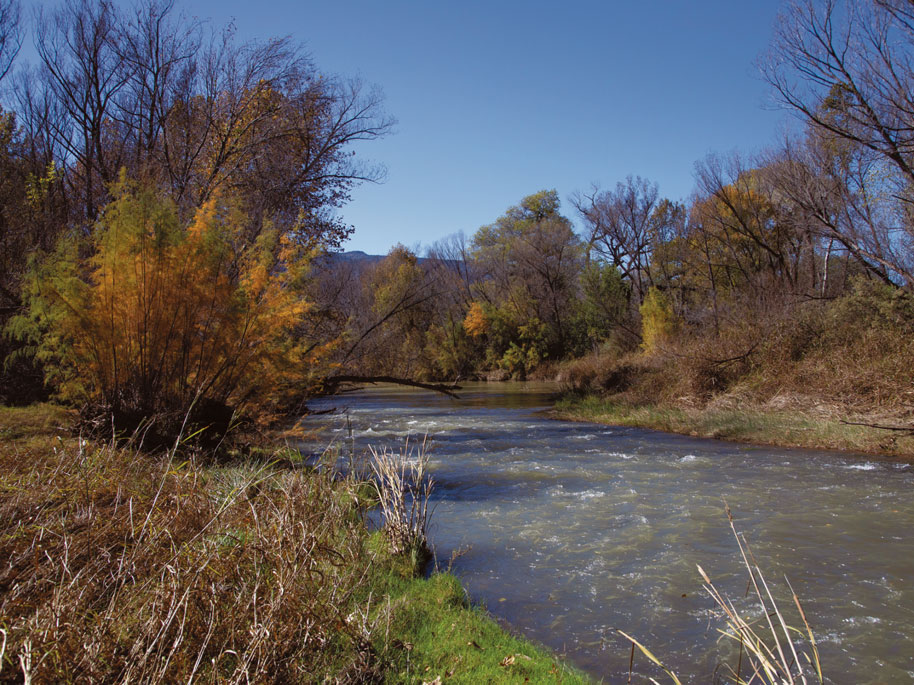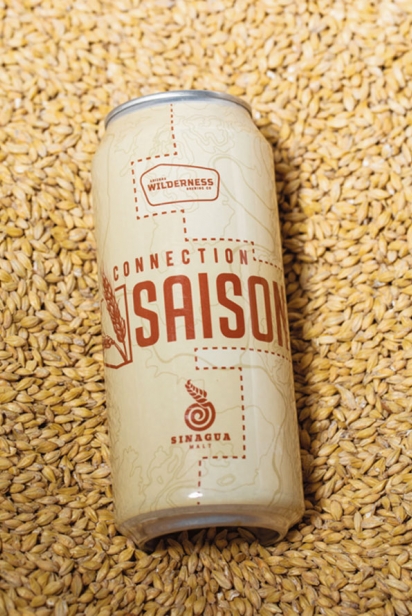Drink Beer; Save a River
Consider Kachina Kolsch, Fossil Creek IPA, Dirty Verde Double IPA and Aravaipa Abbey Dubble— beer monikers that evoke some of the state’s most scenic destinations. For distinctive local flavor, add Arizona tangerines, grapefruit, pine needles and pecans to the brew and the concept of terroir is manifest.
But although regional craft brewers have a tradition of celebrating the land and the landscape of Arizona, a major beer component has been missing until now: regionally produced malt. That’s about to change. Sinagua Malt Company, Arizona’s only commercial malt house, has opened its doors in Camp Verde.
The realization of Sinagua Malt is a complex story of collaboration and creative thinking involving Zach Hauser, a sixth-generation Camp Verde farmer; Kim Schonek of The Nature Conservancy; and Chip Norton, a long-time Verde Valley resident, river enthusiast and entrepreneur.
Zach and his family grow alfalfa and corn for livestock as well as wheat, pecans, melons and sweet corn for people, using water from the Verde River. Devoted to keeping the farm viable for his descendants, Zach knows that conserving water is critical. “If the river wasn’t here, then there would be no farming. I’d rather be part of the solution than part of the problem,” he says.
Kim Schonek, Verde River program manager for The Nature Conservancy, (TNC) works with landowners, ditch associations and farmers on ways to conserve water by replacing flood irrigation with drip systems, installing high-tech monitors to control sluice gates and ditch flows and replacing crops with lower-water-use options.
Focusing on the third option, Zach and Kim came up with the idea of growing malt barley in the winter to replace irrigation-intensive summer-grown feed corn. Barley uses less water and less fertilizer than corn and grows when the demand for river water is lower. Plus, sold to bakeries and breweries it earns higher prices than livestock feed grains.
In late 2015 Zach planted 15 experimental acres of malt barley at TNC’s Shield Ranch outside Camp Verde. The February 2016 harvest was abundant and of good quality. So in the fall of 2017 he successfully planted 125 acres.
“What we needed,” says Kim, “was a malt house. We wanted to establish a market-based solution to river conservation challenges. It was an important opportunity to integrate conservation, and to protect food production and local agriculture.”
Enter Chip Norton, a retired public works contractor with expertise in process equipment. Chip cherishes the river, its riparian wildlife and the agrarian life-ways of the community. A charter member of the conservation group Friends of the Verde Greenway, he has also served as Verde Natural Resource Conservation District supervisor.
Chip says that his mission has been “to make a positive difference in the use of the river water and enable sustainable economic development: I thought, ‘How can we make this happen?’”
Embracing the concept of the barley project, he researched the market and met regional craft brewers who would be eager customers. With some backers he launched Sinagua (“without water” in Spanish) Malt Company.
Set up as a Benefit Corporation, Sinagua Malt (like Newman’s Own) has certain tax advantages in light of its economic and environmental contributions to the community. Chip is now the pro-bono manager.
Housed for now in a new, spanking-clean RV repair shop, the equipment for Sinagua Malt comprises an array of large stainless-steel tanks with climate-control mechanisms and computer monitor panels. On a recent visit, a few dozen halfton sacks of raw barley and finished malt sit on pallets. Yann Raymond, Chip’s assistant, is high on a ladder at the top of the 1,500-gallon steeping tank, checking on the soaking barley inside.
Asked what makes a good malt barley, Chip says, “The qualities we look for are plumpness in the grain, a high germination rate, a protein range of 9–12% and absence of disease.”
Yann brings a handful of recently malted grain to taste. Delicately crunchy, it has a lightly toasted, nutty aroma and sweet caramel flavor. Cleaned of its hulls it would make a tasty snack.
With the array of dials, screens and gauges, it’s clear that the process is complex (see the malting process sidebar).
“We are learning as we go” Chip says. “It takes a year to complete the malt cycle process to determine a good recipe. We know what we are after, but each grain varietal is different, and we have to tweak the recipes. We have developed a couple of recipes for each of the varieties currently planted.”
“It is critical to keep the quality of the enzyme package, and so far our extract process has been good. But we are striving for above-average,” he says.
Chip is referring to the bundle of enzymes and starches that are generated in the sprouting process of the grain. While heat advances the process, high temperatures can adversely affect the quality of the malt.
Chip keeps a close eye on the gauges throughout the three stages of the malting process. Hot temperatures, rain, and even power outages, can affect the moisture in the grain as well as the temperature and timing. In Camp Verde the barley holds the summer heat, so Chip introduced a heat exchange to lower the water temperature during the initial steeping.
“We must discern nuances between batches. We are working with three grain varietals to determine their suitability in this challenging climate, and right now we’re testing one for the second time.”
Such is the meticulous art and science of the malting process.
Happily, beer drinkers in Arizona can now enjoy the results of their efforts. A few Arizona craft brewers who champion the superior quality of non-industrial, locally produced malt have been eager to purchase the malt for their brewing. They also assist in developing the malting protocol. “The brewers are more like partners than clients,” says Chip. “They want to help us develop the best recipes and work closely with us on that.”
The demand for the malt far exceeds their current production capacity. Eventually they hope to have over 300 acres planted in malt barley, enough to produce hundreds of tons of malt.
An iconic river renewed, a heritage family farm preserved and a dynamic new business in place that ensures a supply of malt for local breweries. The result is a libation for all to enjoy, and a healthy environment to sustain the farms, the wildlife and the water of the Verde River.
For more information, see sinaguamalt.com.
Beer Brewed with Sinagua Malt
To taste some product, I attended a recent O.H.S.O. Tap Takeover gathering at the Arizona Wilderness Brewing Company in Gilbert. Sinagua malt is a star ingredient in their renowned, delicious craft beers. They use it in 94% of their brews right now and aim to use it in 100% soon.
On a Thursday night the place was crowded with diners and after-work libation patrons. It was hard to choose from the dozen or so beers on tap, but luckily the owners Jonathan Buford and Patrick Ware offer five-ounce servings, so one can sample multiple offerings. Their expansive beer menu is partnered with a large menu of sandwiches, salads and burgers, based on local beef and dairy products, and local seasonal vegetables. (The duck fat fries are a highlight—and they are delicious!)
Because I favor traditional brews over infused beers, I chose the Wilderness Pils to start. Golden and dry, the 4.3% alcohol by volume (ABV) beer was a perfect balance between medium hops and the light, toasty-malted grain from Camp Verde. It complemented the food without competing with it.
Next, I tried the “guest brew” from O.H.S.O. Brewery. This was called Con Agua (“with water” in Spanish), and described as a “5% sweet and malty Mexican lager, with a rustic hop bill [list of grain ingredients].” The toasted malt flavor definitely came through in a smooth finish.
That evening Chip was honored with a magnum of a limited-release primitive farmhouse ale called Earthing the Vortex. It was inspired by a visit to Camp Verde that Patrick and Jonathan made with friends to enjoy some R&R on the river. As they made their way along the banks, they harvested juniper branches, black walnuts and walnut bark to concoct an original Verde River recipe to celebrate the river, the land and the plants of the area.
Look for Sinagua Malt in beer from these brewers:
O.H.S.O. Brewery
locations in Gilbert, Arcadia, Scottsdale and Paradise Valley
THAT Brewery
3270 N. Hwy. 87, Pine
300 E. Cherry St., Cottonwood
Wren House Brewery
2125 N. 24th St., Phoenix
Arizona Wilderness Brewing Company
721 N. Arizona Ave., Gilbert










